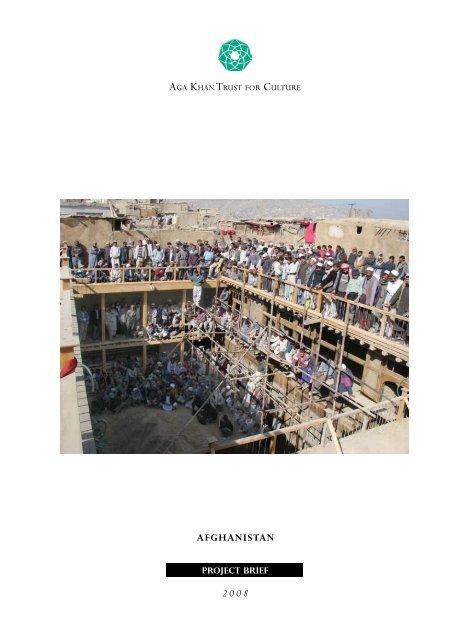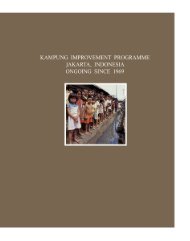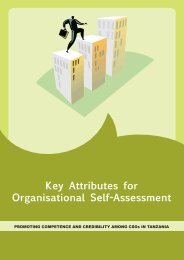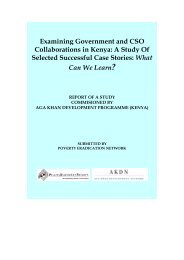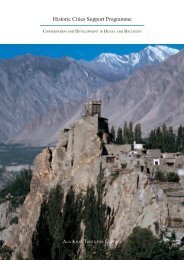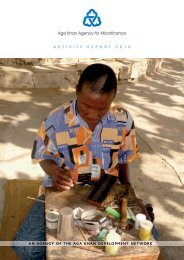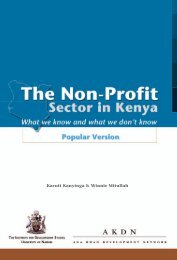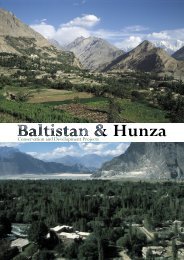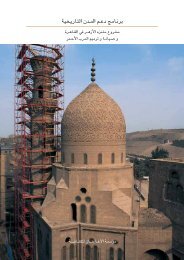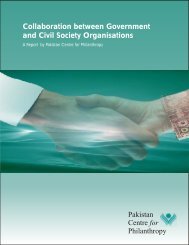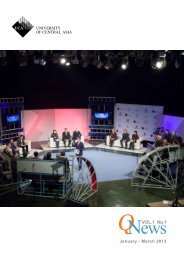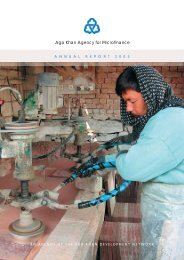Project Brief on Afghanistan - Aga Khan Development Network
Project Brief on Afghanistan - Aga Khan Development Network
Project Brief on Afghanistan - Aga Khan Development Network
Create successful ePaper yourself
Turn your PDF publications into a flip-book with our unique Google optimized e-Paper software.
<strong>Aga</strong> <strong>Khan</strong> Trust for CultureafghanistANproject brief2 0 0 8
Introducti<strong>on</strong>In 2002, the <strong>Aga</strong> <strong>Khan</strong> Trust for Culture (AKTC) signed an agreement with theInterim Administrati<strong>on</strong> of <strong>Afghanistan</strong> to restore and rehabilitate a number ofsignificant historic buildings and public open spaces in the city of Kabul. Sincethen, a range of c<strong>on</strong>servati<strong>on</strong> and urban regenerati<strong>on</strong> efforts, living c<strong>on</strong>diti<strong>on</strong>improvements, community development programmes and planning initiativeshave been implemented in war-damaged neighbourhoods of the Old City ofKabul. A similar initiative commenced in the Old City of Herat in 2005. TheTrust is also involved in the preservati<strong>on</strong> of intangible cultural heritage in<strong>Afghanistan</strong> through the <strong>Aga</strong> <strong>Khan</strong> Music Initiative in Central Asia.BAghe babur, kabulIn early 2003, c<strong>on</strong>servati<strong>on</strong> began of the sixteenth-century Baghe Babur inKabul, where the first Mughal Emperor Babur is buried. Now managed byan independent Trust, the restored 11-hectare garden not <strong>on</strong>ly re-establishesthe historic character of the site with its water channels, planted terraces andpavili<strong>on</strong>s, but also provides the populati<strong>on</strong> of Kabul with a space for recreati<strong>on</strong>and cultural events. The bulk of physical works were completed by 2007,since when the various facilities – including a swimming-pool, garden Pavili<strong>on</strong>,caravanserai and Queen’s Palace complex – have been in public use. In additi<strong>on</strong>to the c<strong>on</strong>servati<strong>on</strong> work in Baghe Babur, investments have been made inupgrading basic infrastructure for residents of the surrounding neighbourhood,while the joint formulati<strong>on</strong> of a District Acti<strong>on</strong> Plan c<strong>on</strong>tinues.In 2008, Baghe Babur has seen a steady increase in number of visitors, withsome 60,000 per m<strong>on</strong>th in mid-summer. Since the introducti<strong>on</strong> of a new systemof management under the Baghe Babur Trust, with participati<strong>on</strong> from KabulMunicipality, the Ministry of Informati<strong>on</strong> and Culture and AKTC, there has alsobeen an appreciable increase in revenue. In order to ensure that the restoredlandscape and m<strong>on</strong>uments can be maintained to appropriate standards, theTrust aims over time to achieve financial sustainability by generating revenuefrom entrance fees and appropriate public events in the various facilities.(Top) Terraced walkways and water channels leadup the sloped access to the garden Pavili<strong>on</strong>. Sinceopening, Baghe Babur has become a populardestinati<strong>on</strong> for the citizens of Kabul.(Middle) The swimming pool in Baghe Baburoffers a cool respite from Kabul’s summer heat.(Above) Since completi<strong>on</strong> in 2007, the newcaravanserai in Baghe Babur has been used for avariety of cultural events.C<strong>on</strong>servati<strong>on</strong> of Timur Shah Mausoleum, kabulLocated in a busy commercial area in central Kabul, c<strong>on</strong>servati<strong>on</strong> of theeighteenth-century Timur Shah Mausoleum commenced in 2003. In additi<strong>on</strong>to safeguarding an important historic landmark, the project has enabled thetraining of Afghan professi<strong>on</strong>als and craftsmen, as well as the reclamati<strong>on</strong> ofa sizable garden around the m<strong>on</strong>ument, which had over recent years beenencroached up<strong>on</strong> by informal traders. Since its c<strong>on</strong>servati<strong>on</strong>, the mausoleumhas been regularly used for public meetings and exhibiti<strong>on</strong>s, while visitors canagain make use of the park, which stretches down to the Kabul River and hasbeen replanted with mulberry trees, as in the original garden.
Urban Regenerati<strong>on</strong> PRojects in kabulThe Asheqan wa Arefan neighbourhood, which takes its name from an importantshrine at its centre, represents <strong>on</strong>e of the last surviving clusters of historicfabric in the Old City, which suffered massive damage in the early 1990s. Sinceearly 2003, 11 homes and 15 historic public buildings have been c<strong>on</strong>served,and the living c<strong>on</strong>diti<strong>on</strong>s of more than 60 households improved through accessto small-scale grants and building advice in this and adjacent areas. A range ofupgrading measures have been undertaken, including paving of alleyways andselected streets, al<strong>on</strong>g with the c<strong>on</strong>structi<strong>on</strong> of drains and improvement ofwater supplies. This rehabilitati<strong>on</strong> has benefited nearly 20,000 residents andgenerated some 80,000 work/days of employment, while the c<strong>on</strong>servati<strong>on</strong>works has provided the opportunity for training of more than 60 apprenticesunder the instructi<strong>on</strong> of 15 master-craftsmen and 65 skilled labourers. Effortshave been made to protect and upgrade public open space through the old city.In the case of Zarnegar Park, to the north of the old city, a degraded space hasbeen transformed through re-planting, installati<strong>on</strong> of irrigati<strong>on</strong>, paving andprovisi<strong>on</strong> of public facilities. The Park now provides a shady respite <strong>on</strong> a dailybasis for thousands of visitors. Am<strong>on</strong>g the socio-ec<strong>on</strong>omic initiatives supportedin the Old City are home-based training and literacy courses for women, andthe operati<strong>on</strong> of a restored community bath-house, whose revenue is used tomeet the costs of neighbourhood upgrading. A sec<strong>on</strong>d bath-house is currentlyunder restorati<strong>on</strong>.AKTC staff c<strong>on</strong>tinue to work closely with members of the Kabul Old CityCommissi<strong>on</strong> to oversee development in the historic fabric, as well as providingtechnical support to planners from Kabul Municipality and the Ministry ofUrban <strong>Development</strong>. In 2008, work began <strong>on</strong> the formulati<strong>on</strong> of a planningframework for the Old City and <strong>on</strong> proposals for a nati<strong>on</strong>al policy for urbanheritage preservati<strong>on</strong>, with support from the World Bank.Herat Old City Rehabilitati<strong>on</strong> Initiative(Top) Life in the Old City of Kabul has improvedwith AKTC carrying out infrastructure upgradingand rehabilitati<strong>on</strong> of housing.(Middle) Interior of the restored Charda MasoomShrine and Mosque in the Old City of Kabul.(Below) A general view of the Old City of Heratwith the restored Malik Mosque and Cistern Complexin the foregroundIn 2005, AKTC initiated a process of mapping of all property in the old city ofHerat, which has taken place in parallel with the c<strong>on</strong>servati<strong>on</strong> of five importanthistoric houses and 17 public buildings, al<strong>on</strong>g with provisi<strong>on</strong> of small-scalegrants to more than 70 households. This work al<strong>on</strong>e has generated more than60,000 work/days of employment. Based <strong>on</strong> surveys of living c<strong>on</strong>diti<strong>on</strong>s,investments have been made in repairs or rec<strong>on</strong>structi<strong>on</strong> of 2,500 metres ofdrain and laying of more than 4,000 metres² of st<strong>on</strong>e paving in pedestrian alleyways.Al<strong>on</strong>g with the removal of solid and liquid waste, these measures havebenefited more than half the residents of the Old City. With technical supportfrom AKTC, an Old City Commissi<strong>on</strong> now oversees urban development andupgrading within the c<strong>on</strong>fines of the historic quarter, as well as formulatingneighbourhood plans and raising public awareness of the need for safeguardingin the Old City and bey<strong>on</strong>d.
Gozargah shrine complexThe grave of the 12th century Sufi poet and scholar. Abdullah Ansari, in Gozargahis <strong>on</strong>e of the most important religious sites in the regi<strong>on</strong>. Situated in the courtyardofan important shrine complex dating from 1425 AD, Ansari’s grave remains animportant focus for prayer and c<strong>on</strong>templati<strong>on</strong> to this day. In order to protect thedistinctive decorati<strong>on</strong> in the complex, repairs have been carried out to all roofs,while access by visitors to the courtyard has been enhanced by brick paving, theinstallati<strong>on</strong> of discreet external lighting and the replacement of modern fittingswhere necessary. Work c<strong>on</strong>tinues <strong>on</strong> documentati<strong>on</strong> and interpretati<strong>on</strong> of thedecorati<strong>on</strong> and dedicati<strong>on</strong>s <strong>on</strong> the many historic graves that lie in the courtyardof the shrine. Parallel restorati<strong>on</strong> work <strong>on</strong> the adjoining Namakdan Pavili<strong>on</strong> (left)and Zarnegar Takiahana is now complete.AKTC’s urban c<strong>on</strong>servati<strong>on</strong> and development work receives supportfrom the governments of Germany, Norway, US, UK and Uzbekistan,as well from as the Prince Claus Fund (Netherlands) and the OpenSociety Institute.<strong>Aga</strong> khan music initiative in central asiaThe <strong>Aga</strong> <strong>Khan</strong> Music Initiative in Central Asia (AKMICA) was created by HisHighness the <strong>Aga</strong> <strong>Khan</strong> in 2000 to support the efforts of Central Asian musiciansand communities to sustain, further develop and transmit musical traditi<strong>on</strong>sthat are a vital part of their cultural heritage. The Music Initiative’s strategy isto c<strong>on</strong>tribute to the revitalisati<strong>on</strong> and c<strong>on</strong>tinuing evoluti<strong>on</strong> of music in CentralAsia by identifying and supporting outstanding musical talent, cultivating newapproaches to musical performance and pedagogy, documenting and disseminatingthe work of leading exp<strong>on</strong>ents of Central Asian music, and stimulating interestin the regi<strong>on</strong>’s music worldwide.(Top) Interior the newly-restored NamakdanPavili<strong>on</strong>, which adjoins the Ansari Shrine Complexin Gozargah.(Above) Homayun Sakhi, <strong>on</strong>e of the outstandingAfghan rubab players of his generati<strong>on</strong>, regularlyperforms as part of the AKMICA programme.In <strong>Afghanistan</strong>, the Music Initiative engaged six masters to offer instructi<strong>on</strong> <strong>on</strong>the premises of AKTC in Kabul. In 2006, another group of ustâds began teachingstudents in historic premises in the centre of the Old City of Herat. The ustâdsprovide instructi<strong>on</strong> to groups of around 20 students in two-hour sessi<strong>on</strong>s threetimes a week. All students are selected <strong>on</strong> the basis of merit, and have to passregular tests to retain their place in the course. While initial enrolment in theTraining Programme was all-male, efforts c<strong>on</strong>tinue to identify female studentsin the various courses, in which some 170 students now receive instructi<strong>on</strong>. TheGovernment of India has provided instruments for these classes.(Cover) The project team in Kabul.For more informati<strong>on</strong> about the <strong>Aga</strong> <strong>Khan</strong> Trust for Culture, please visit www.akdn.org orc<strong>on</strong>tact the <strong>Aga</strong> <strong>Khan</strong> Trust for Culture, PO Box 2049, 1211 Geneva 2, Switzerland.Tel. +41 22 909 7200; Fax. +41 22 909 7292; Email: aktc@akdn.org


